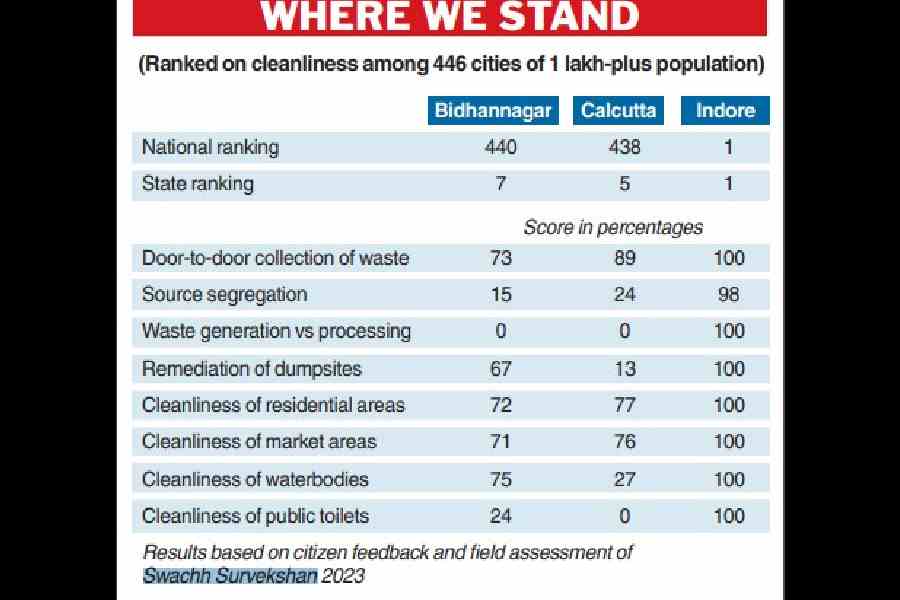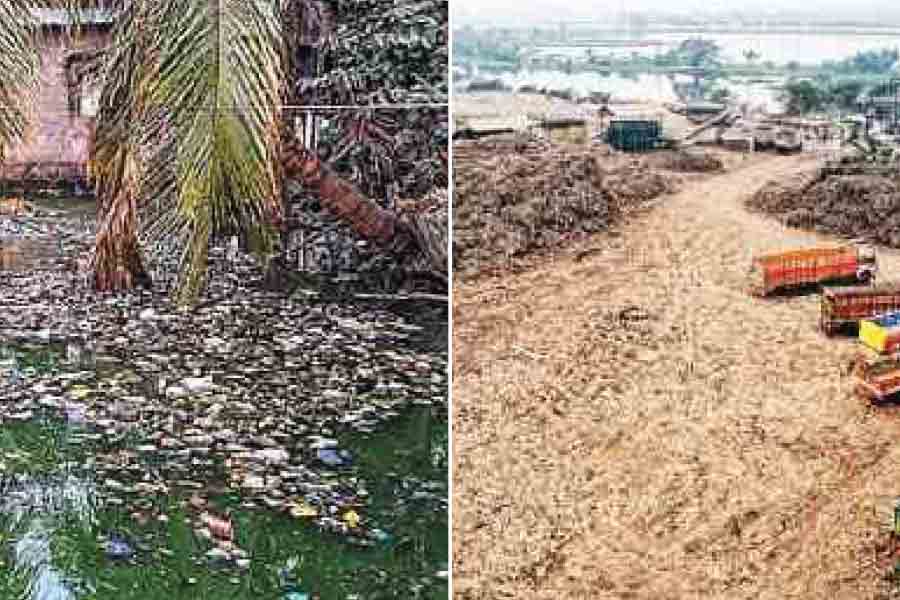It’s a tag that Salt Lake can hardly swallow.
The areas under Bidhannagar Municipal Corporation, that includes Salt Lake, one of the few planned cities in West Bengal, have been ranked seventh in dirtiness among cities having more than one lakh population within the country in Swachh Survekshan 2023, a cleanliness survey carried out by the Union housing and urban affairs ministry. Officials of the civic body have questioned the ranking.
The initiative covered 4,477 cities across the country, irrespective of the population size, which were evaluated based on eight broad parameters — door-to-door collection, source segregation, waste generation versus processing, remediation of dumpsites, cleanliness of residential areas, market, water bodies and public toilets.
The survey was evaluated nationally by more than 3,000 assessors. Incidentally, all the 10 cities at the bottom of the cleanliness list belong to Bengal, including Calcutta – ninth from bottom – and Howrah that has been found to be the dirtiest among 446 cities in the category. Indore, in Madhya Pradesh, has been ranked cleanest in the country with 100 per cent scores in almost all the parameters.
According to the result, of which The Telegraph Salt Lake has a copy, Bidhannagar has slipped mainly due to its poor performance in waste processing – scoring zero — source segregation and cleanliness of public toilets, with 15 and 24 per cent scores respectively. The corporation area performed much better in door-to-door collection – 73 per cent – as well as in parameters like cleanliness in residential areas, markets and water bodies, securing scores of 72, 71 and 75 per cent respectively.
The city has done markedly well in the parameter “remediation of dumpsite”, meaning the removal of old and exhausted dumpsites, scoring 67 per cent marks. This is second only to Champdani, in North 24-Parganas, in the state. The civic body has started to remove old trash from the dumpsite in Mollar bheri area under an order from the National Green Tribunal.
Bengal at bottom
Overall the Bengal towns, not included earlier in similar surveys, fared poorly on several accounts. Among 16 cities, assessed overall, Baidyabati and Tarakeshwar, both in the Hooghly district, were found to be the cleanest in the state, followed by Champdani in Hooghly and Katwa in East Burdwan districts. Bidhannagar was ranked seventh best in the state.
At the state level, if one were to calculate the average of the scores of the 16 towns assessed, the best performance came in cleanliness in market and residential areas — at 69.2 per cent while the score in door to-door collection followed, at 68.6 per cent. The worst score —zero — came in “Waste generation versus processing”, followed by “remediation of dumpsites” with 10.9 per cent. Poor maintenance of water bodies also contributed to the overall state performance, managing only 40.5 per cent as score.
Counterpoint
The reality is different, claimed state municipal affairs and urban development minister Firhad Hakim. Speaking to The Telegraph Salt Lake, he said: “The report is biased and meant to malign the image of West Bengal and push private agencies into the waste management sector in the state.
So many people have come to our cities in recent times and applauded their cleanliness.” Bidhannagar’s mayoral-council-member in charge of waste management Debraj Chakraborty echoed the view. “The ground reality is entirely different,” he said. A state government official, who did not want to be named, felt that the state’s decision not to formally join the survey might have contributed to the poor rankings of its cities as all the relevant data might not have reached the survey officials. “The results only reflected the study findings,” observed a Union government official involved with the study, refusing to be named.
Incidentally, in September 2022, the National Green Tribunal had imposed a penalty of Rs 3,500 crore on the West Bengal government for its poor performance in waste management, particularly for failing to plug the huge gap in solid and liquid waste generation and treatment.
Incidentally, all the cities being assessed in Bengal failed to score in waste treatment. Doubts cast “The assessment does not reflect the actual status of the Bengal cities in waste management. Take the example of Calcutta. Strangely the city was marked zero in waste processing despite running a 500 metric tonne plant to convert biodegradable waste to manure.
Recently another 500 tonne plant for processing construction and demolition of waste had been opened. Similarly, Bidhannagar deserves better marks,” observed AA Block resident Arunabha Majumdar, a retired director of All India Institute of Hygiene and Public Health and a waste management expert.

Bidhannagar officials also questioned the score given to the Corporation area, including Salt Lake, which many see as the benchmark of cleanliness in the state. “We have started door-to-door collection in 100 per cent households while segregation at source could be initiated in 57 to 62 per cent households.
Definitely, we deserve better marks,” claimed a senior official in the urban local body. Another official, however, admitted that the long distance that has to be covered in the transportation of garbage has been slowing down the waste management process. “Now by order of the green tribunal, we must dump our waste in Dhapa.
Though the Calcutta Municipal Corporation has allotted us a dedicated space, it takes quite some time for the vehicles to travel all the way and dump the trash. That slows down the process,” he said. “We cannot completely deny the markings as clearly, the emphasis in the state is to keep the major thoroughfares and key neighbourhoods clean while several provisions of the waste management act of 2016 get routinely flouted,” alleged Naba Dutta, an environment activist associated with the green platform Sabuj Mancha.
What we saw
The Telegraph Salt Lake took stock of the cleanliness of the township and here is what we saw. l Segregated door-to-door waste collection Although the Bidhannagar Municipal Corporation had started distributing colour-coded bins to residents of the township — blue for non-biodegradable waste and green for biodegradable waste — for segregating their domestic waste, the practice has been hardly adopted on ground. Many residents claim that civic workers mix up the waste at the compactor stations, thus, making their efforts to segregate useless. We also witnessed a compactor station near City Centre where the waste was fed into the compactor machine without being segregated. lMachine-assisted cleaning of manholes The manholes in Salt Lake are cleared by mechanised gully pit emptiers. However, there are a few human scavengers who, according to a senior official of the civic body’s solid waste management department, are occasionally deployed when the manholes get totally choked. l Upcycling, recycling, and usage of biodegradable items There is not a single upcycling facility in Salt Lake. New Town has a zero-waste shop where people can walk in with items that they want to get rid of, be it old clothes or defunct laptops and mobile phones. Several wastepaper bins on the streets carry contact numbers of a private player, Hulladek, which collects e-waste on request from users across the city.
